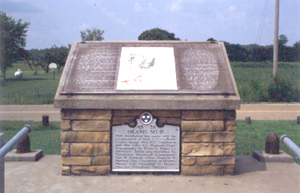
Battle of Island #10
The opening of hostilities between the Confederate States and the United States in the spring of 1861 found both belligerents woefully unprepared for the struggle ahead. Confederate strategists realized that the Mississippi River offered a broad avenue of invasion into the South; the river had to be defended if Southern independence was to be realized. Confederate control of the Mississippi River was vital to the unification of the seceding states east and west of the Mississippi Valley and could effectively cripple the agricultural economy of the midwestern states of the Union.
Early in the war, the Confederate forces under the direction of General Leonidas Polk fortified Island #10, near the Kentucky-Tennessee state line. In 1861 Island #10 was part of a chain of islands in the Mississippi River lying below Cairo, Illinois, that led into the heart of the Confederacy. It was so named for its position as tenth in this chain from north to south.
A Confederate force of approximately 7,000 troops manned the island defenses. General W. W. Mackall was in command at the time of the Union attack in March 1862. Seven Union gunboats under the command of Flag Officer Andrew H. Foote bombarded the island for three weeks. Heavy bombardment, high water, and the successful movement of the Union gunboats past the Confederate guns forced the surrender of the island on April 7, 1862. Polk evacuated as many soldiers as possible on an assortment of river transports while under fire from two of Foote’s gunboats. Union soldiers pursued the retreating Confederates into the swamps and captured over six thousand prisoners near Tiptonville, Tennessee.
With the collapse of Island #10’s defenses, military activities moved farther south, effectively ending Confederate control of northwest Tennessee for the duration of the war.
Suggested Reading
Lonnie White, “Federal Operations at New Madrid and Island Number Ten,” West Tennessee Historical Society Papers 17 (1963): 47-67



